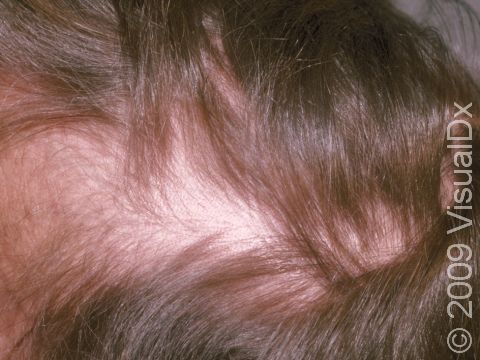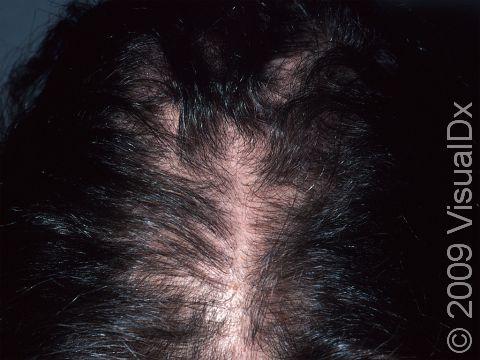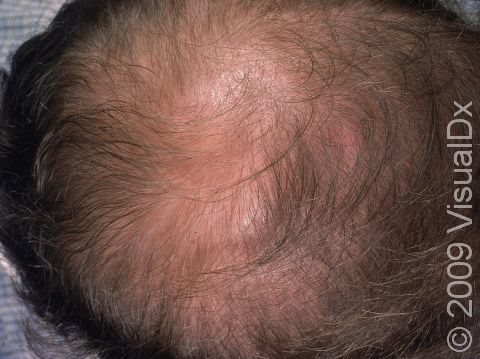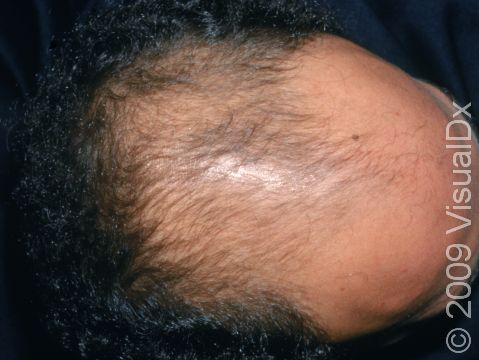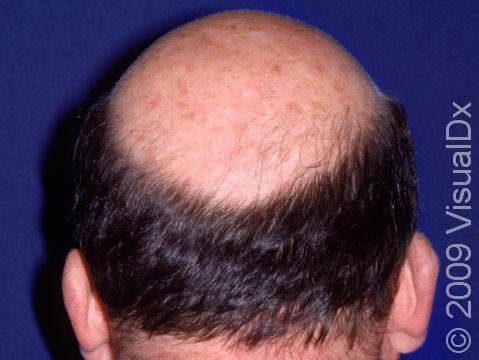Hair Loss, Male Pattern Baldness (Male Pattern Alopecia)
Male pattern baldness (alopecia), or androgenetic alopecia, is a common hair loss that affects men. The condition is not considered a medical disorder, but it can affect both the appearance and self-esteem of men. This type of hair loss often has a genetic basis, and a type of testosterone called dihydrotestosterone often plays a role in male pattern alopecia.
Who's At Risk?
Male pattern alopecia affects men of nearly any age, although it is more common as age increases. It can also affect any race / ethnicity, but it is most common in White men, followed by Asian men and Black men.
Signs & Symptoms
The most common location for male pattern alopecia is at the frontal hairline. Hair loss may then move toward the back of the scalp. Alternatively, it may first be noted as thinning at the crown of the scalp. The skin of the scalp often appears normal (eg, there is no skin color change), and small hairs may be seen in the area.
Self-Care Guidelines
The hair loss associated with male pattern alopecia, although permanent, requires no treatment if you are comfortable with your appearance.
Hair loss can have a significant psychologic impact. Creative hair styling or hairpieces can help to minimize the effects of hair loss.
Those with male pattern alopecia should take measures to protect their scalp from ultraviolet (UV) radiation with sunscreens, hats, or hairpieces.
Topical minoxidil 5% (eg, Rogaine) is available without a prescription. This may help the hair to grow in some men, and it will stop or slow hair loss in most. The medication is expensive, however, and note that the hair loss will rapidly progress when minoxidil use is discontinued. Wash your hands thoroughly after applying minoxidil. Residue left on the hands can be harmful if transferred to pets.
Treatments
The diagnosis of male pattern alopecia is usually straightforward for the medical professional because of the typical pattern of hair loss. However, certain blood tests will help rule out other causes of hair loss, such as low blood count (anemia) or a thyroid disorder. A skin biopsy may be recommended.
Oral finasteride (Propecia, Proscar) or oral minoxidil (Loniten) may be prescribed.
Specialized centers may offer platelet-rich plasma scalp injections to stimulate hair growth.
Surgical therapy to improve the appearance of alopecia includes scalp reduction, flaps, and hair transplants (micrografting). Note that not everyone is considered a good candidate for these procedures.
Visit Urgency
Although male pattern alopecia is not a medical disorder and it does not require medical care, see a medical professional if you would like to find out more about cosmetic restorative therapy.
If you are experiencing hair loss or if there is redness, itching, or skin changes associated with the hair loss, seek medical advice, as there are sometimes other causes for hair loss or other issues that can coincide with hair loss that should be treated.
Some individuals with male pattern alopecia have psychological symptoms, such as feelings of helplessness, preoccupation with hair loss and aging, and loss of self-esteem. If you have these sorts of feelings, seek medical care.
Trusted Links
References
Bolognia J, Schaffer JV, Cerroni L. Dermatology. 4th ed. Philadelphia, PA: Elsevier; 2018.
James WD, Elston D, Treat JR, Rosenbach MA. Andrew’s Diseases of the Skin. 13th ed. Philadelphia, PA: Elsevier; 2019.
Kang S, Amagai M, Bruckner AL, et al. Fitzpatrick’s Dermatology. 9th ed. New York, NY: McGraw-Hill Education; 2019.
Last modified on November 14th, 2025 at 9:20 am

Not sure what to look for?
Try our new Rash and Skin Condition Finder
